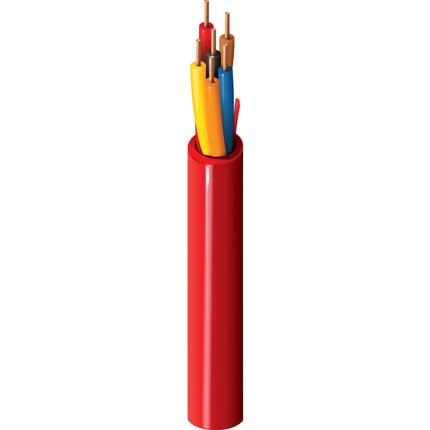In this article, we will look at plenum cables, what they are made of, and when it can be appropriate to use them.
When installing cables, it is essential to choose the right type for your specific application. Plenum cables are used specifically in the plenum space of a building. The plenum space is an area that is used for airflow with air heating and air conditioning systems and this is found either above a room or below it, via a raised floor. Installing cables in the plenum space can provide a number of benefits if done with proper intent.
Plenum Cables Used in High-risk Environments
especially for communications, such as local area network (LAN). Plenum provides plenty of routing space as well as providing easy access between all rooms, making it ideal for future upgrades. However, the plenum space of a building carries a particularly high fire risk as there are no fire breaks between rooms and these spaces can also easily transport toxic smoke from those same fires.
Plastic is a particularly troublesome material when it comes to fire as it is readily combustible as well as releasing toxic, thick black smoke when burned. As a result, standard cables cannot be used in plenum spaces as fires would easily spread between rooms using the cabling as the “fire conduit”. Therefore, only “plenum-rated” cables can be used in these spaces. Plenum-rated cables are different from standard cables as they are both fire-resistant as well as being “low-smoke” (meaning that when they do burn, albeit very slowly, the cable produces little smoke).
Using the Correct Type of Plenum-Rated Cables is Crucial
Building regulations have been in place for hundreds of years and have evolved to ensure that buildings are safe for those inside and in surrounding areas. These regulations have become vast in size and encompass almost anything that can be used in a domestic environment including electricity, water, and gas.
Electrical cabling is no different and using the right type and size is essential if the installation is to comply with local law. For example, cables often have to follow a color code where live wires are either red or brown and neutral wires are blue or black. This scheme allows for repair work to be done safely in the future as well as making wire identification easier.
Wires also have to be of a specific size to ensure that they can carry the current that is required of them. Wires that are too small can overheat quickly and become a fire risk while cables that are buried in walls surrounded by insulation will not be able to carry their rated current safely as they will not be able to dissipate the heat generated by natural resistance in the cable.

A fire alarm cable, Plenum-FPLP, 6-18 AWG.
Advantages and Drawbacks of Using Plenum-Rated Cables
While plenum cables are great for their fire-retardant properties, they do have some disadvantages. The first is their high cost due to their specialized design which is why many designers will use plenum cables only in plenum spaces. Plenum cables are often stiffer than regular cables due to their fire-retardant coatings which means that they are more prone to insulation tearing. The increased stiffness of the cable also means that plenum tables typically require a larger bend radius to ensure that the insulation does not tear.
When installing cables into plenum spaces its essential that plenum-rated cables are used for legal and safety reasons. However, while plenum cables are great for fire risk environments they are not without their faults and using plenum cables in low-risk environments can make their advantages mute. Plenum cables are can be just for communication use only and rarely (if at all) for power but technologies such as PoE can allow such cables to power and provide networking capabilities.
What is your experience with plenum rated cables?
Copyright Statement: The content of this website is intended for personal learning purposes only. If it infringes upon your copyright, please contact us for removal. Email: admin@eleok.com
